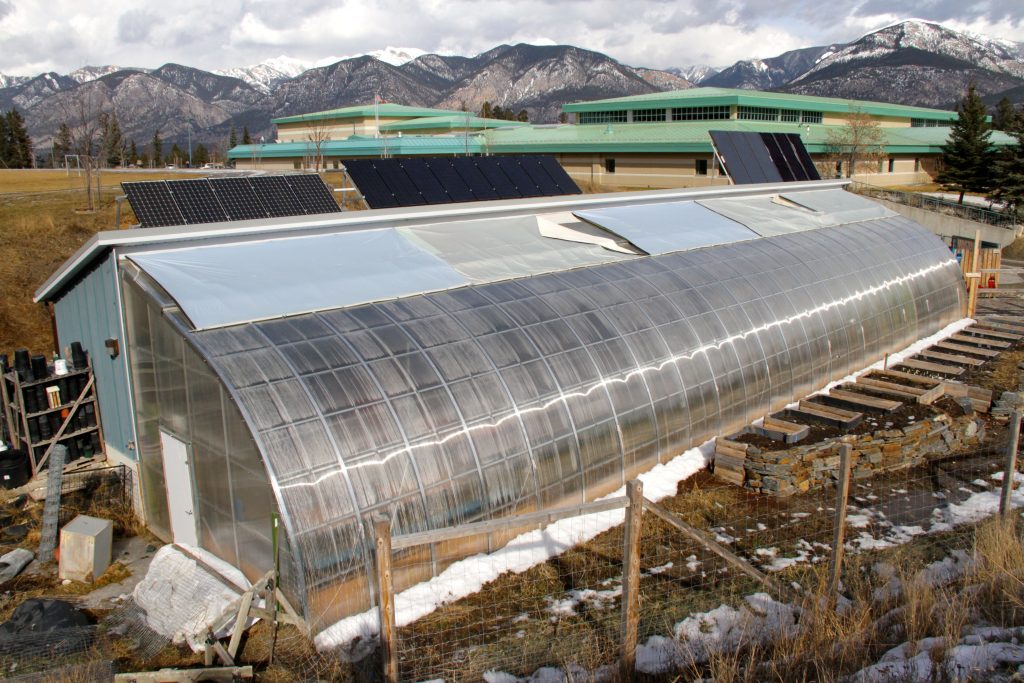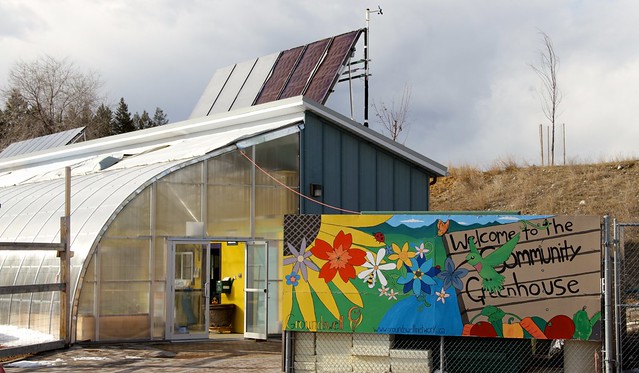By David Dodge and Duncan Kinney
A passive solar greenhouse in Invermere B.C. is making people across the continent sit up and takes notice. What is a passive solar greenhouse? Don’t they already use the sun’s energy? Well yes but with the traditional Dutch glass box greenhouse design all that heat leaves once the sun goes down. These uninsulated buildings don’t store any of that heat and as a result use a ton of energy to either heat the building at night or move excess heat out during the day. Energy wise, they just don’t make sense for most of Canada.
We wanted to see it in action and that’s why we visited the Groundswell Network Society’s community passive solar greenhouse in Invermere, B.C.
The first thing they did was to get rid of the north-facing glass wall that loses heat and doesn’t bring in light. That north facing wall and the back half of the building was replaced with a roof and a thermally massive concrete wall and floor structure designed to keep the heat in and store heat captured from the sun and release it overnight. On the front of the building, facing south is the only glass this greenhouse has – a large curved, glass wall. The roof has solar PV panels to generate electricity and it also has a solar thermal hot water system that heats an in-floor concrete heating system. And finally it has an annualized geo-solar system where hot air is collected from the ceiling and pumped underneath the building.

Groundswell Community Network’s greenhouse is a new kind of passive solar greenhouse that maximizes solar inputs and reduces energy waste. Photo David Dodge, Green Energy Futures
But does it blend?
Does the design work? When we visited in early March it was -1C outside and a pretty grim, grey day. Inside the greenhouse the temperature was already approaching 20C. It’s been in operation since 2009 producing a ton of delicious veggies and herbs. The building has no furnace and it acts as a season extender. They can start plants in February and still be harvesting the last of the tomatoes in November.
“I think why greenhouses aren’t all like this is because we live in an era of very inexpensive energy. And what we’ve tried to demonstrate here is to anticipate the change in that reality that many in the food sector believe is coming,” says Bill Swan, the executive director of the Groundswell Community Network.
“One of the figures I’ve seen is there’s 10 units of carbon fuel energy in every food unit we consume. And it’s not just in the movement of that food around the world, it’s in the production of that food. A lot of our fertilizers are carbon-fuel based, so the whole systems takes an enormous amount of energy to get food to our table,” says Swan.
The Groundswell greenhouse is a community hub. It had 35 different funders and more than 300 volunteers helped with construction. The 400 member organization also manages a couple of community gardens, runs gardening and permaculture workshops, has a worm composting operation and a lot of the food they grow ends up being used in the high school next door in its cafeteria and culinary arts program.
Andrea Salzbrenner is the chef-training instructor at David Thompson Secondary School and is big fan of this ground to table approach.
“Our students are able to go down to the greenhouse, grow food, harvest it, bring it back up to the school and then enjoy food that is minutes old, as opposed to coming overseas and across country.”
The lessons learned from the design are invaluable and people are coming from all over North America to see what they’re doing. While this type of design is in heavy use in China, it’s just starting to get traction in North America. Rob Avis, who we’ve featured before on Green Energy Futures in our episode on rocket stoves, built one in his backyard and even recently published an e-book on their design.
But whether you’re building a greenhouse or a home these passive solar and thermal mass lessons are simple and can be applied almost anywhere. Face your building south, maximize the size your south facing windows, cut down on the amount of north facing windows and use thermally massive materials to soak up heat.
Bill Swan sees a day when these types of simple greenhouse structures ubiquitous, a low cost, low energy way to keep yourself in groceries.
“I think the home of the future will always have a greenhouse either attached or closely associated with it for these benefits of energy and for food.”
While the Dutch style greenhouse is popular they don’t make sense in places where it’s sunny and it gets cold at night. By adapting greenhouse designs to local climate conditions we can use far less energy to grow local, healthy food.






